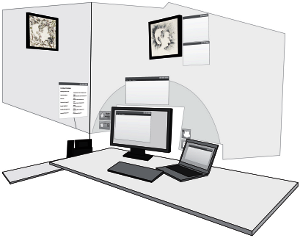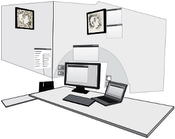Information
- Publication Type: Conference Paper
- Workgroup(s)/Project(s):
- Date: May 2013
- ISBN: 978-1-4503-1952-2
- Publisher: ACM
- Location: Paris, France
- Lecturer: Manuela Waldner
- Booktitle: POWERWALL: International Workshop on Interactive, Ultra-High-Resolution Displays, part of the SIGCHI Conference on Human Factors in Computing Systems (2013)
- Conference date: 27. April 2013 – 2. May 2013
- Pages: 1 – 6
- Keywords: information management, ubiquitous displays
Abstract
Large, high-resolution display spaces are usually created by carefully aligning multiple monitors or projectors to obtain a perfectly flat, rectangular display. In this paper, we suggest the usage of imperfect surfaces as extension of personal workspaces to create ubiquitous, personalized information spaces. We identify five environmental factors ubiquitous information spaces need to consider: 1) user location and display visibility, 2) display gaps and holes, 3) corners and non-planarity of the display surface, 4) physical objects within and around the display surface, and 5) non-rectangular display shapes. Instead of compensating for fragmentations and non-planarity of the information space, we propose a ubiquitous information space manager, adapting interaction and window rendering techniques to the above mentioned factors. We hypothesize that knowledge workers will benefit from such ubiquitous information spaces due to increased exploitation of spatial cognition.Additional Files and Images
Weblinks
No further information available.BibTeX
@inproceedings{waldner-2013-ubiWM,
title = "Towards Ubiquitous Information Space Management",
author = "Manuela Waldner and Dieter Schmalstieg",
year = "2013",
abstract = "Large, high-resolution display spaces are usually created by
carefully aligning multiple monitors or projectors to obtain
a perfectly flat, rectangular display. In this paper, we
suggest the usage of imperfect surfaces as extension of
personal workspaces to create ubiquitous, personalized
information spaces. We identify five environmental factors
ubiquitous information spaces need to consider: 1) user
location and display visibility, 2) display gaps and holes,
3) corners and non-planarity of the display surface, 4)
physical objects within and around the display surface, and
5) non-rectangular display shapes. Instead of compensating
for fragmentations and non-planarity of the information
space, we propose a ubiquitous information space manager,
adapting interaction and window rendering techniques to the
above mentioned factors. We hypothesize that knowledge
workers will benefit from such ubiquitous information spaces
due to increased exploitation of spatial cognition. ",
month = may,
isbn = "978-1-4503-1952-2",
publisher = "ACM",
location = "Paris, France",
booktitle = "POWERWALL: International Workshop on Interactive,
Ultra-High-Resolution Displays, part of the SIGCHI
Conference on Human Factors in Computing Systems (2013)",
pages = "1--6",
keywords = "information management, ubiquitous displays",
URL = "https://www.cg.tuwien.ac.at/research/publications/2013/waldner-2013-ubiWM/",
}


 Position Paper
Position Paper
